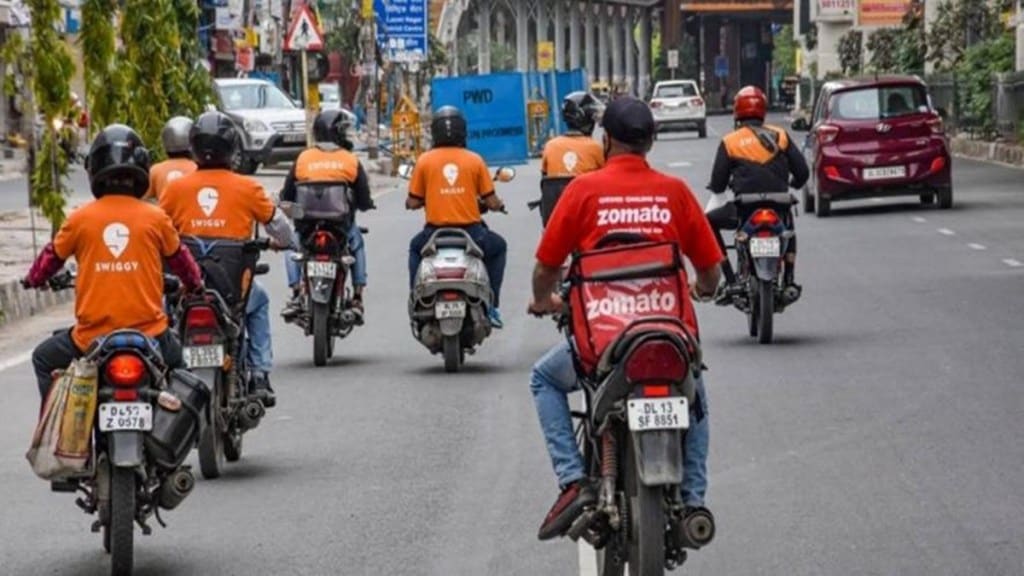As Bengaluru celebrated Ganesh Chaturthi recently, delivery platforms saw a sharp spike in orders for sweets, flowers and last-minute puja essentials. For delivery workers, it meant long hours, congested streets and constant order notifications across multiple apps.
Festival days, once a chance for shorter shifts and steady earnings, have now become the busiest and most demanding periods. Three years ago, delivery workers could make Rs 600-800 with around 20 orders in a day. This year, many are working 14-15 hours and completing nearly double the number of deliveries, only to earn roughly the same amount.
More orders, less money
Analysts say that the imbalance reflects a deeper shift in the gig economy. Platforms are preparing to hire more than 260,000 seasonal workers this festive season–a 20-25% rise from last year. But while companies celebrate the growth, workers face falling per-order payouts and rising workload.
Data from staffing firms show that during festive weeks, gig workers deliver 60-80% more orders daily compared with regular days. Yet per-order payouts have fallen by as much as 25% over the past year.
“Quick commerce is leading the surge with a projected 35-40% increase in hiring, while e-commerce is set to expand by 25-30%,” said Deepesh Gupta, director and head of general staffing at Adecco India. But this demand is paired with declining unit economics. “During the festive season, gig workers are expected to handle 22-32 orders on average per day, compared to 12-18 orders during regular months,” he added.
Per-order rates in quick commerce have seen the steepest drop. Gupta said that payouts, which ranged between Rs 34 and Rs 42 in 2024, have slid to Rs 22-30 in 2025, with some platforms paying as little as Rs 15-25 per delivery. Surge bonuses of Rs 13- Rs 15 are offered during peak hours, but the benefits are often cancelled out by heavy traffic, which reduces the number of orders workers can complete.
Longer shifts, mounting fatigue
The impact on working hours is stark. According to Balasubramanian Anantha Narayanan, senior vice-president at TeamLease, festive season shifts now stretch to 12-14 hours, compared to the regular 8-10. The longer shifts are often necessary to unlock surge bonuses and meet higher delivery targets, said Sachin Alug, CEO of NLB Services.
The combination of lower payouts and longer hours is taking a toll. “This whole industry is scaling faster than the humans keeping it alive. More orders, lower pay per order equals fatigue, faster churn,” wrote Madhav Kasturia, founder and CEO of logistics platform Zippee, in a recent LinkedIn post.
Urban markets have been hit hardest. The flood of dark stores and riders in large cities has created oversupply, pushing down per-order rates even further. “Larger urban markets typically see higher order volumes but lower per-order payouts, coupled with sharper fluctuations in demand and persistent rider shortages,” Gupta said.
Unpredictable external factors add to the strain. Weather remains a critical disruptor, said Kasturia. “One rainstorm can lead to 30-40% fewer active riders.” Workers are then forced to either endure difficult conditions or make up lost income during clear weather, further stretching their shifts.
The disconnect between booming hiring figures and the reality of workers’ earnings raises questions about sustainability. Platforms continue to expand, offering faster deliveries and greater convenience to customers. Yet for those keeping the system running, the gains are shrinking.
“They say business is booming. For us, it just means harder work and more stairs to climb,” a delivery worker said.
Analysts note that the challenge for the fast-growing delivery sector is not about creating more jobs. The real test is whether those jobs would provide stable income or the workers would remain stuck in a cycle of doing more work for less reward.


